Affiliate disclosure: This post may contain affiliate links. Please see our Privacy Policy.
Gardener’s hand soap is a springtime essential, perfect for scrubbing off dirt and grime while nourishing hardworking hands. This easy melt and pour soap making recipe incorporates wildcrafted herbs and garden weeds into a simple homemade gardener’s soap that’s as beautiful as it is effective.
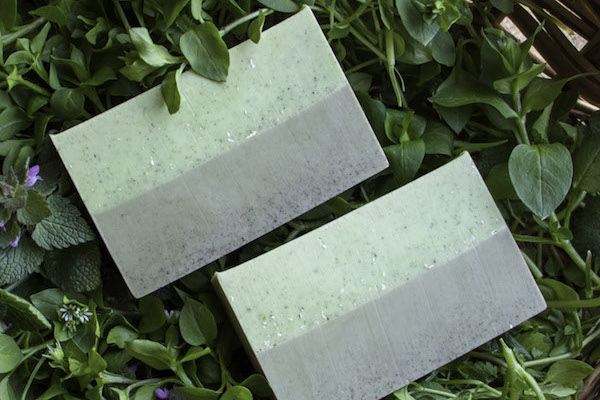
Nobody appreciates a good bar of quality soap like a gardener (except maybe a mechanic…). Gardener’s hands take a beating in the sun and soil, and they need something that can scrub the dirt away while at the same time nourishing the skin.
Thus gardener’s soap was born!
This particular gardener’s soap is a simple melt and pour recipe, that incorporates spring weeds for their healing properties. Bentonite clay, diatomaceous earth and a pinch of pumice powder make this soap as hard-working as it is nourishing.
The recipe comes from Jan Berry’s book, Easy Homemade Melt & Pour Soaps. I love Jan’s book, and she has a skill for taking simple ingredients and transforming them into real works of art.
While my desire to create is pretty well boundless, my creativity is limited. Jan provides detailed instructions for making truly jaw-dropping homemade melt and pour soaps, and her creativity is seemingly endless.
There are just so many ideas in this book, and many of them include natural herbs and botanicals for the nature-inspired body products.
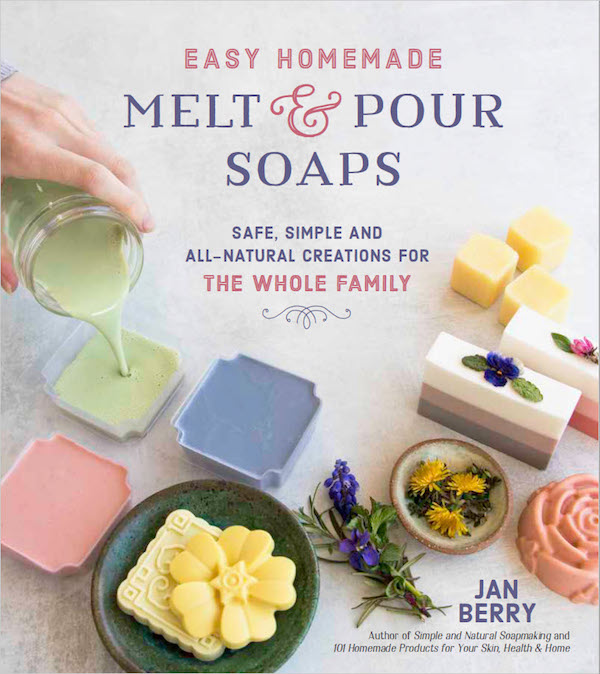
Making Melt and Pour Gardener’s Soaps
I hear it all the time….”I’d love to make soap at home, but I’m afraid to work with lye. Isn’t there a way to make my own soaps without lye?”
Melt and pour soaps are just that. The art of homemade soap, without the worry of working with lye.
I’ll admit, when I first started making homemade soaps, I turned up my nose at melt and pour. That’s not real soapmaking! Or so I thought.
Years later, I know better. Saponification is a simple reaction between oils in a soap, and it’s all over rather quickly. The artistry of soapmaking happens after that initial reaction, as the soapmaker determines the real character fo the soap after the lye has reacted with the oils.
Starting with melt and pour, you’re skipping that initial risky lye-based step and starting where the fun begins!
When making melt and pour soaps, you still have to decide on colors, fragrances, shapes, nourishing oils, exfoliants, and botanicals. There is so much left to do, and so much space for creativity.
This gardener’s soap recipe starts with a simple shea butter base or goats milk soap base, and then the real magic begins…

Choosing Herbs & Weeds for Gardener’s Soap
Many garden weeds (and herbs) are nourishing for the skin.
- Chickweed, in particular, is perfect for nourishing inflamed or chapped skin.
- Jewelweed naturally relieves itching from poison ivy and bug bites.
- Dandelion is clarifying for the skin as well.
- Comfrey has pain-relieving properties and is used to help heal cuts and scrapes.
- Plantain is known as nature’s band-aid and is often used in topical preparations.
- Purple Dead Nettle is anti-inflammatory, anti-bacterial, and anti-fungal, making it perfect for small abrasions and sore hands.
If you don’t know the particular actions of a given weed, obviously don’t use it. Many edible weeds are also great for topical use, just do a bit of research if you’re not sure.
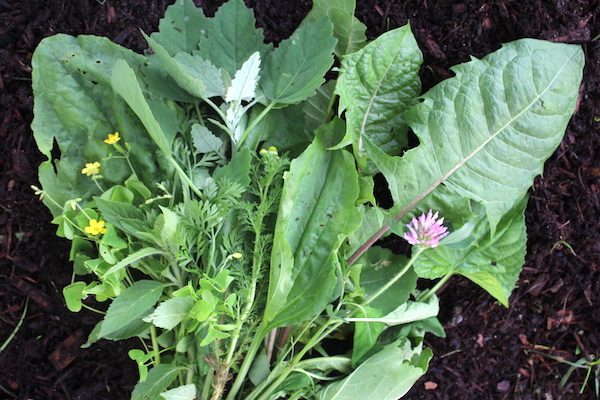
Here’s the guidance Jan provides at the beginning of this recipe for gardener’s soap:
“Although a multitude of weeds are well-loved by herbalists for their beneficial properties, sometimes as gardeners, we need to pull them up to make room for planting veggies and other foods for our table. In this recipe, we put those lovely weeds to good use, incorporating them into an exfoliant-loaded soap that’s perfect for scrubbing up after a day’s labor in the garden.
Consider using one or more of these safe, common weeds that are prized for their nourishing benefits: chickweed, violet leaves, and flowers, dandelion leaves and flowers, plantain leaves, and purple deadnettle.”
If you choose to use other wild weeds and herbs, just do your homework ahead of time and make sure they’re safe for topical use (and have properties that align with your goals).
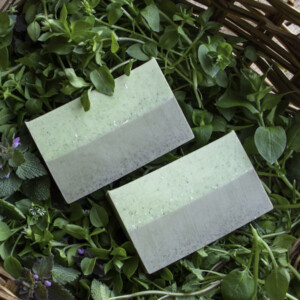
Spring Weeds Gardener's Soap ~ Easy Melt and Pour Recipe
Equipment
Ingredients
- 1/2 cup 7g chopped fresh or wilted weeds (see list in notes)
- 1 tbsp 15ml water
- 20 oz 567 g shea butter or goats milk soap base, cut into 1'' cubes
- 1/2 tsp cucumber seed oil or your favorite oil
- 3 g ~3/4 tsp bergamot essential oil
- 1 g ~1/4 tsp rosemary essential oil
- 1/2 tsp bentonite clay
- 1 tsp diatomaceous earth
- 1/2 tsp pumice powder
- 1/2 tsp honey
- 1 1/2 Tbsp finely ground oats
- 1 tsp green zeolite clay or french green clay
- Rubbing alcohol for spritzing optional, but recommended for appearance
Instructions
- In a heatproof 4 cup glass measuring container, combine the chopped weeds, water, and soap base. Cover the top lightly with a heatproof saucer. Place the container in a saucepan containing a few inches of water, forming a makeshift double boiler.
- Heat over medium-low heat until the soap is almost melted, about 20 to 35 minutes. Then lower the heat down to very low and infuse for an additional 30 minutes, stirring occasionally, until the soap has taken on a noticeable green color from the plants.
- Remove the pan from the heat and strain the soap mixture to remove the plant material.
- Stir in the cucumber seed oil and essential oils.
- Divide the soap base in half by pouring 10 ounces (283 g) of the melted soap into a separate container. Return the original container of the remaining soap base to the pan of still hot water, to keep it warm until needed.
- Into the second container, mix the bentonite clay, diatomaceous earth and pumice powder. Stire thoroughly until they're completely incorporated. Let it cool for several minutes to 125 to 130 degrees F (52 to 54 C) so that the additives are less likely to settle to the bottom of the soap.
- Stir well one more time, then pour it into the bottom of a 4'' (10 cm) silicone loaf mold. Spritz the top of the soap with alcohol and let it sit undisturbed for about 20 minutes.
- Remove the container of soap from the pan of warm water and check its temperature. If it has formed a skin on top, or is too thick to work with, reheat briefly until it is fluid again.
- Add the honey, ground oats, and green zeolite clay (or french green clay) to the warm soap and stir well until they're completely incorporated. Let it cool to 125 to 130 degrees F (52 to 54 C).
- Spritz the layer of soap already in the mold with alcohol again, then carefully pour the 2nd mixture into the mold, forming the top layer. Spritz the top with alcohol to remove air bubbles.
- Keep the soap in the mold for 6 to 8 hours, or overnight, until it's completely cooled and hardened. Unmold and slice the soap into bars, laying the loaf on its side to reduce the chance of the layers' separating.
- Wrap the bars tightly and store them in a cool, dry place, out of direct sunlight.
Notes
More Homemade Herbal Body Products
Want to make more all-natural nature-inspired homemade body products? Here are a few more to try:
- Homemade Herbal Shampoo
- Homemade Herbal Infused Oil
- Arnica Oil and Salve
- Goats Milk and Honey Melt and Pour Soap
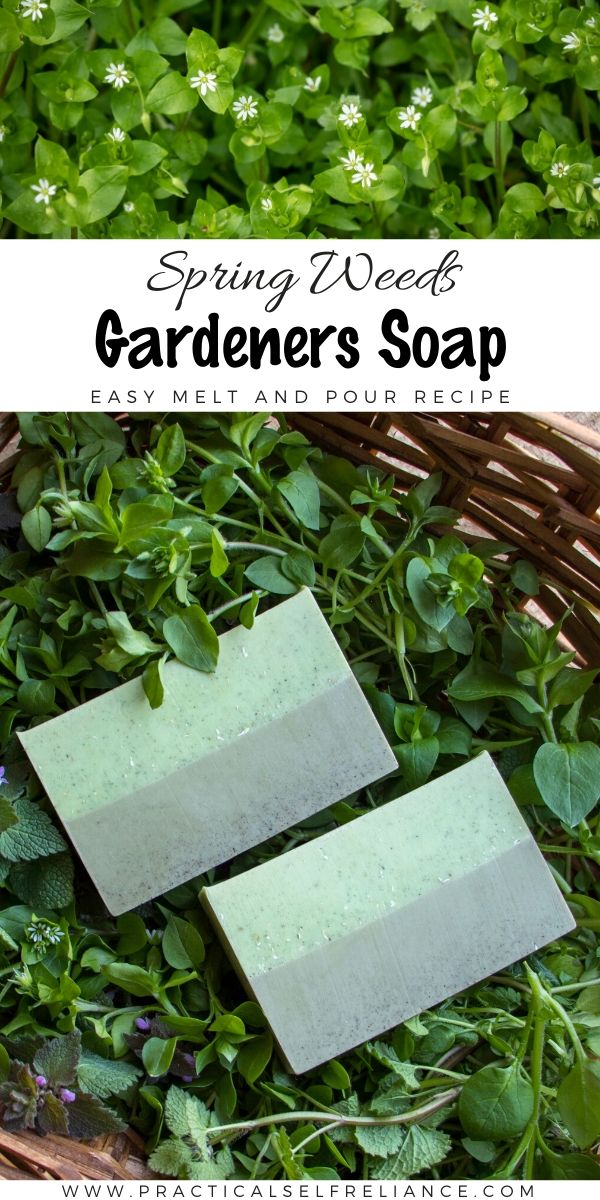
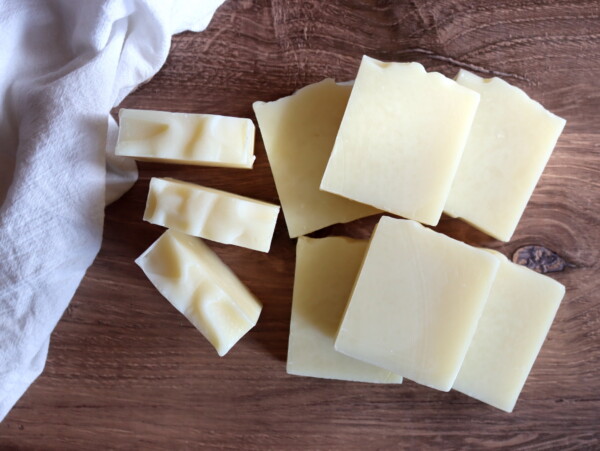
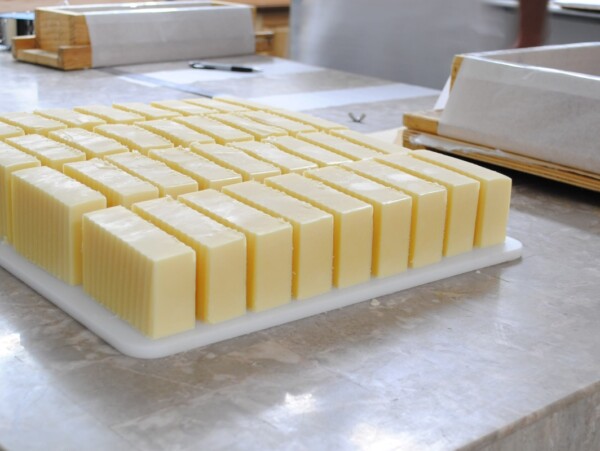
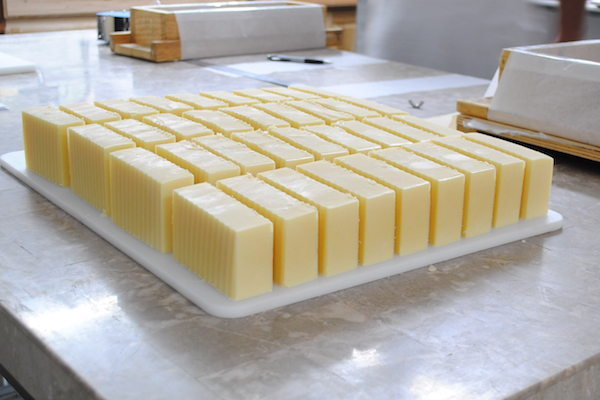
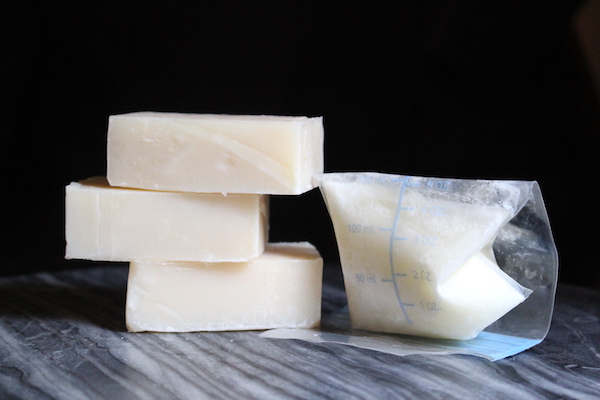










I have always wanted to do this. Thanks for the “weeds” recipe for they are all very healthy plants to use and for free!
You’re welcome!
I made all of my soaps with melt and pour and I love using creativity with it! I can’t wait to try some different weeds, etc that I have never thought about! What malt and pour do you find is your favorite to work with?
I really like melt and pour goats milk soap thus far.